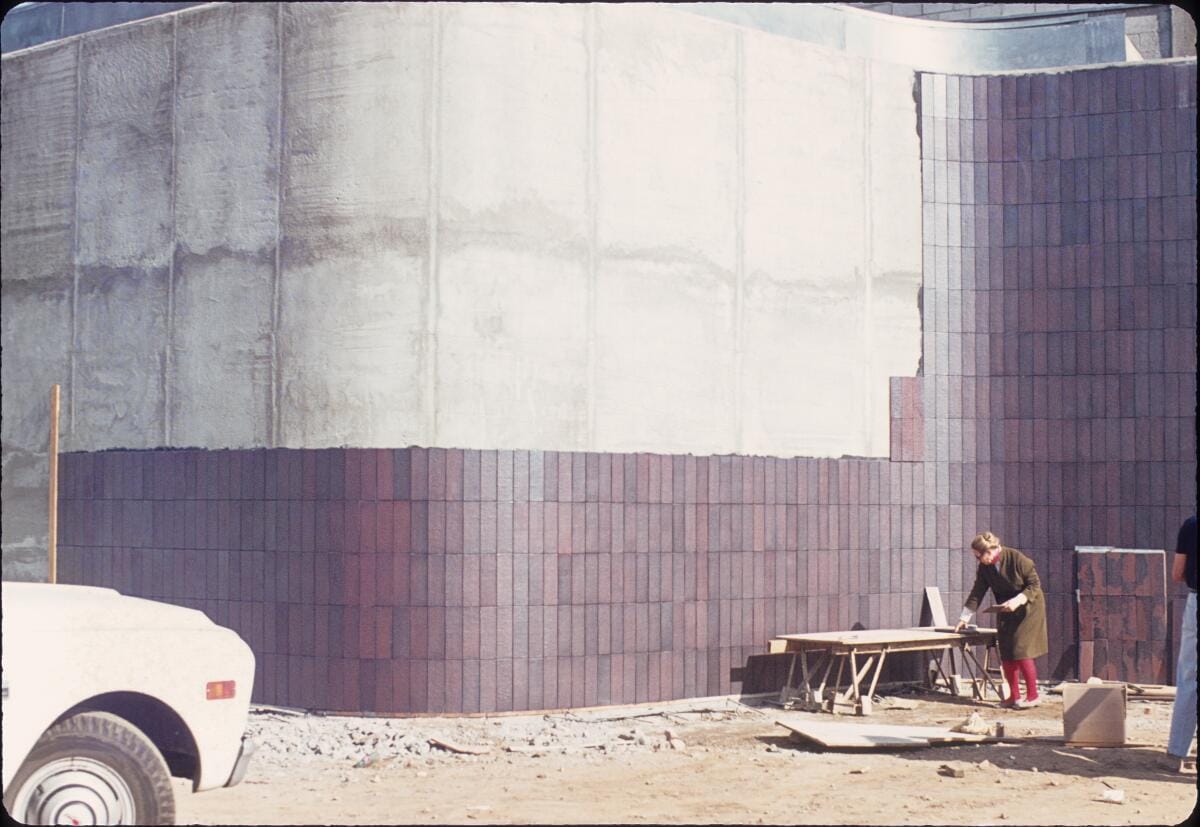Norton Simon Museum reintroduces itself to L.A. with huge renovation
The largest work of art in the Los Angeles area by a woman might just be a museum.
The Norton Simon Museum in Pasadena is covered almost entirely in 115,000 hand-crafted architectural tiles created by ceramicist Edith Heath in 1969. Those tiles, affixed to the facade of a curvilinear building designed by architects Thornton Ladd and John Kelsey, have recently been cleaned and refurbished as part of a $15-million renovation designed to reintroduce the underappreciated museum to the public by making its exterior match the quality and beauty of the rare art inside.
The Heath tile is one of Norton Simon’s “superpowers,” said project architect Liz MacLean, a principal at the firm Architectural Resources Group, which specializes in historic preservation. “I think people drive by this museum all the time and have no idea that it’s clad with Edith Heath tile.”
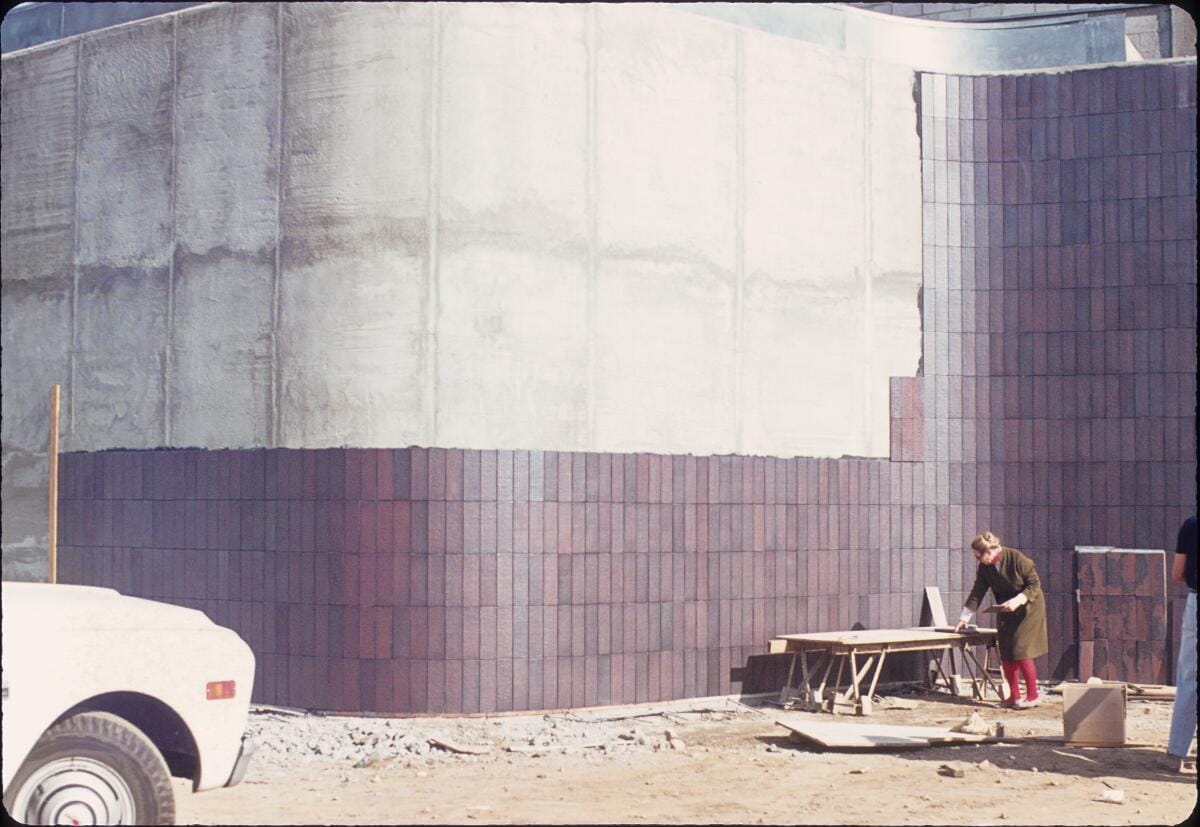
Edith Heath attaching her tiles to the Norton Simon Museum in 1969. Heath would go on to be the first non-architect to win the Industrial Arts Medal from the American Institute of Architects for her work on the building.
(The Brian and Edith Heath Foundation and the Environmental Design Archives, UC Berkeley)
It’s not just the tile made by a groundbreaking ceramicist and innovator of midcentury modern tableware that people often drive by without recognizing — it’s the museum itself, said Norton Simon Vice President of External Affairs Leslie Denk.
The 85,000-square-foot museum — housing a private collection of 12,000 objects including work by Rembrandt, Degas, Picasso, Fragonard, Goya and Vuillard — and its 79,000-square-foot sculpture garden, dotted with work by Jacques Lipchitz, Henry Moore and Robert Morris, are situated on a steeply graded wedge of land girded by bustling Colorado Boulevard, and the traffic-snarled 134 Freeway, near where it meets the 210.
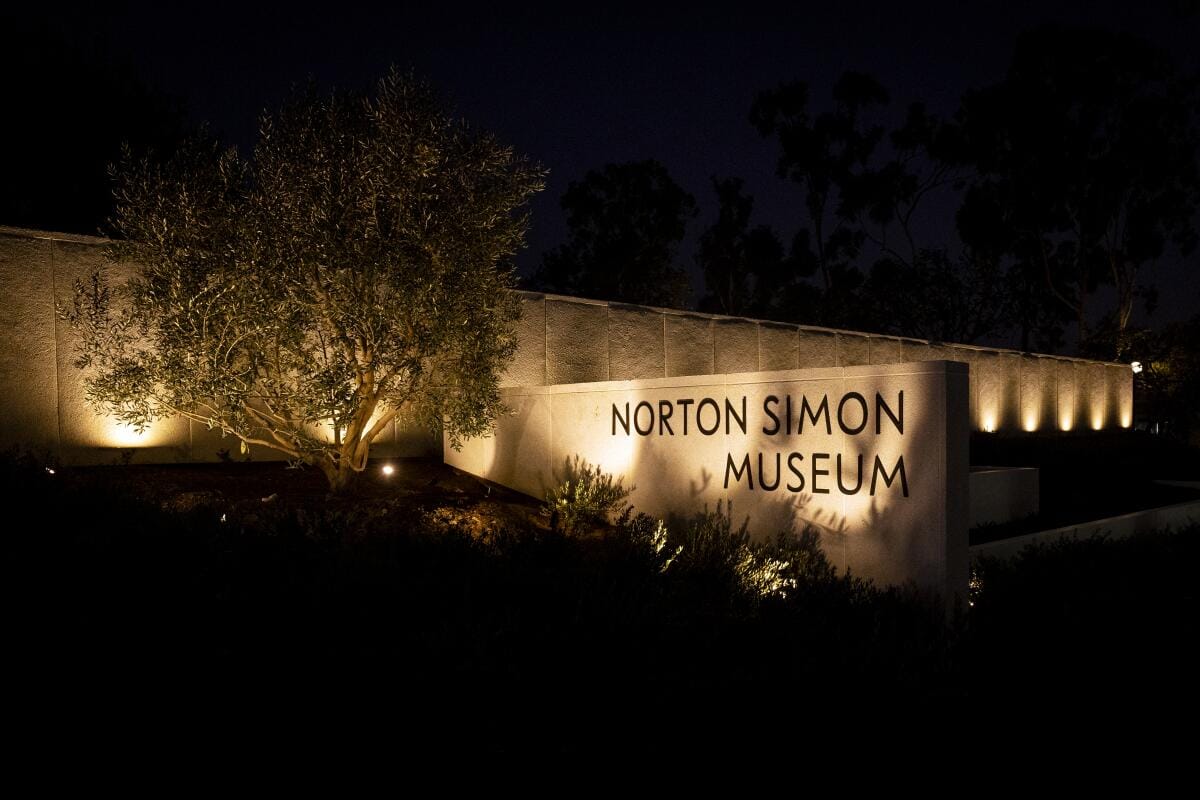
The new signage at the entrance of the Norton Simon Museum in Pasadena. Improving the curb appeal of the museum was the original goal of the renovation, which expanded to include refurbishing the Heath tiles and beloved sculpture garden.
(Etienne Laurent / For The Times)
The signage signaling the museum’s presence along one of Pasadena’s busiest thoroughfares was underwhelming and easy to miss, and the landscaping along Colorado Boulevard was overgrown and wide open. People would sometimes leave their shopping carts from a nearby Ralphs grocery store beside the entrance, not seeming to notice it at all. They also seemed unaware that French artist Auguste Rodin’s famed 1880 sculpture “The Thinker” had been sitting contemplatively along the street for decades — in a spot that no one appeared to realize was open to the public.
The sculpture was originally placed beside the main Norton Simon sign so that it would be visible to cameras filming the Rose Parade, but Denk said that when she recently watched a telecast, the sculpture was obscured by trees. That this iconic work was going unseen was representative of the museum’s problem as a whole.
Conversations about improving the Norton Simon’s curb appeal began a decade ago, said Denk, with the hope of unveiling new signage and entryways in time for the museum’s 50th anniversary celebration.
The space was built in the 1960s for what was originally called the Pasadena Art Museum, but that organization fell on rough times, and in 1974, industrialist Norton Simon — who had become a prominent art collector — took over the building, which reopened under his name in 1975. The last significant work on the museum — a $5-million renovation — was done in 1995 by architect and former museum trustee Frank Gehry.
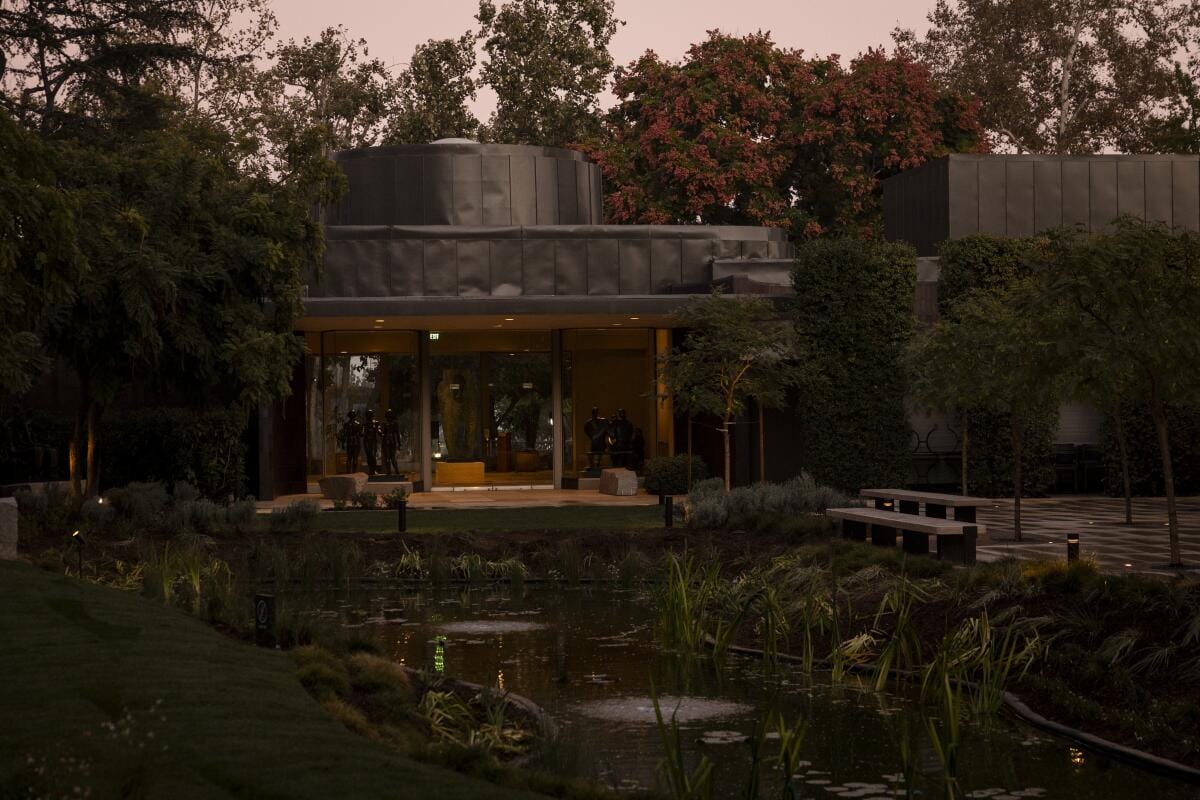
The lobby of the Norton Simon Museum and its back garden pond, which was reduced in size and lined with concrete. It was also connected to a fountain that helps block the sound of nearby traffic.
(Etienne Laurent / For The Times)
Thirty years later, the need for more upgrades became paramount.
“What the museum was looking to do was to really improve our street presence, to elevate the way we present ourselves along Colorado Boulevard,” Denk explained. “There was a disconnect between the way we looked along the street to the experience of walking into the galleries.”
The renovation conceived to remedy this quandary naturally expanded to include a long-overdue restoration of the Heath tiles, as well as a refreshed sculpture garden with new resin-bound gravel pathways. A running fountain now connects to a concrete-lined pond with a reduced footprint to invite more foot traffic and allow for more community events, and walls have been erected to block traffic noise from nearby freeways. Crucially, a new pedestrian-friendly entryway has been constructed, alongside welcoming podium signage with fencing and pole banners that gaily announce the museum to the public.
The work, which took a total of 10 months, was scheduled to start on Jan. 7 — the same day that wildfires began tearing through the Pacific Palisades and Altadena, which borders the museum to the north. The campus was locked down immediately and no smoke infiltrated the galleries, said Emily Talbot, vice president of collections and chief curator, but the sculpture garden looked as if a hurricane had torn through it.
The restoration took on added meaning in the days that followed, Talbot said.
“This building’s design was intended to be in dialogue with the mountains, and so its preservation now just feels all the more significant and important,” she said.
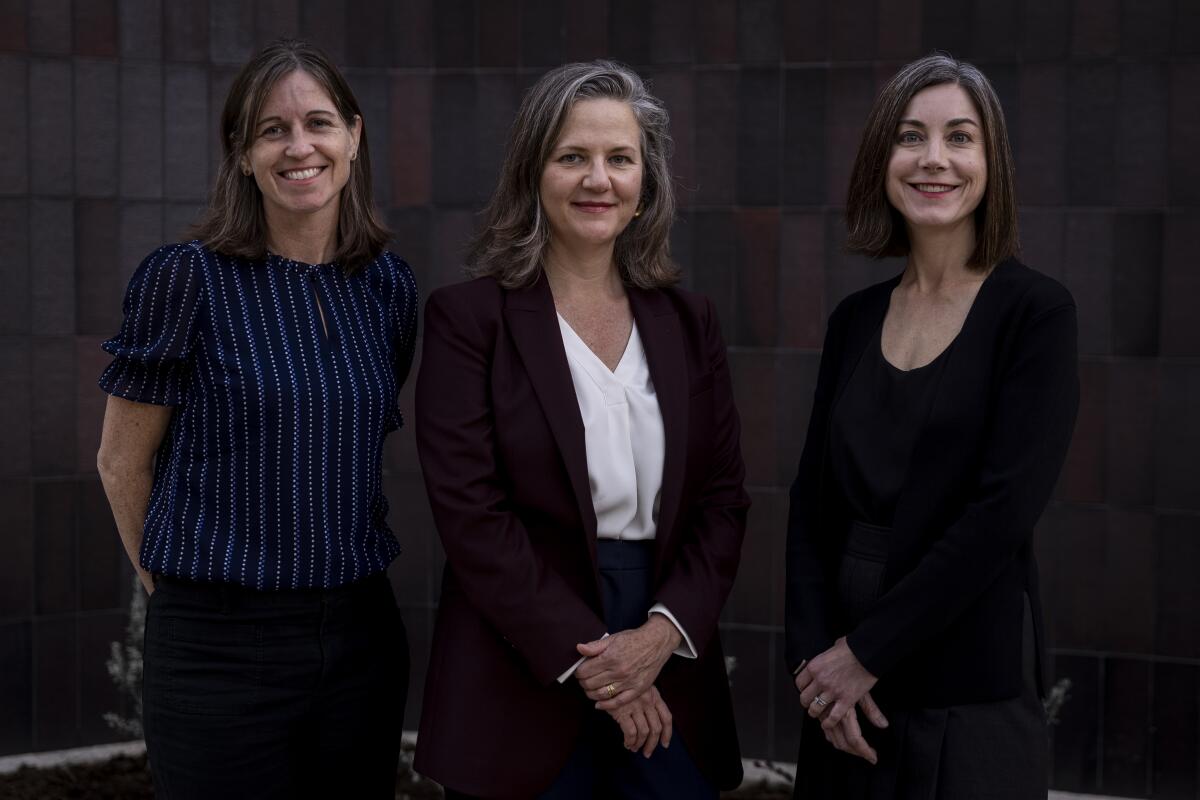
Project architect Liz MacLean, from left, Norton Simon Museum Vice President of External Affairs Leslie Denk and Vice President of Collections and Chief Curator Emily Talbot. “It really is a work of art,” MacLean said of the Heath tiles that cover the building.
(Etienne Laurent / For The Times)
The mottled brownish-red of the Heath tiles is a huge part of that environmental dialogue, and on a recent sun-soaked Friday they shone with a radiant luster under an azure sky. Before the restoration they were cracked and dirty — some had fallen off altogether and others were marred by biological growth. ARG began the process of identifying which tiles needed the most remediation by doing a photorealistic laser scan of the building that MacLean described as a sort of high-tech x-ray.
Twelve artisans at Heath Ceramics, which still operates in the Bay Area, created 3,000 new tiles by hand. The process was complicated, MacLean and Denk note, because the workers had to re-create the tiles with a new formula. The original included materials like lead, which can no longer be used. So they had to test out different processes of glazing in order to make the tone and texture match the old tiles as closely as possible. They ended up using a two-part glaze and also created an entirely new mold since the tiles are not a standard shape.
After the first pressing in the clay, the final tiles shrank about 12%, said MacLean, so the fabricators had to conduct many trials to get just the right size. There were places on the facade where a single tile needed to fit in the grout on the wall. This work was done by Gardena-based company KC Restoration, which retouched and treated each damaged or cracked tile with the type of care and attention to detail used by painting conservators, Denk said.
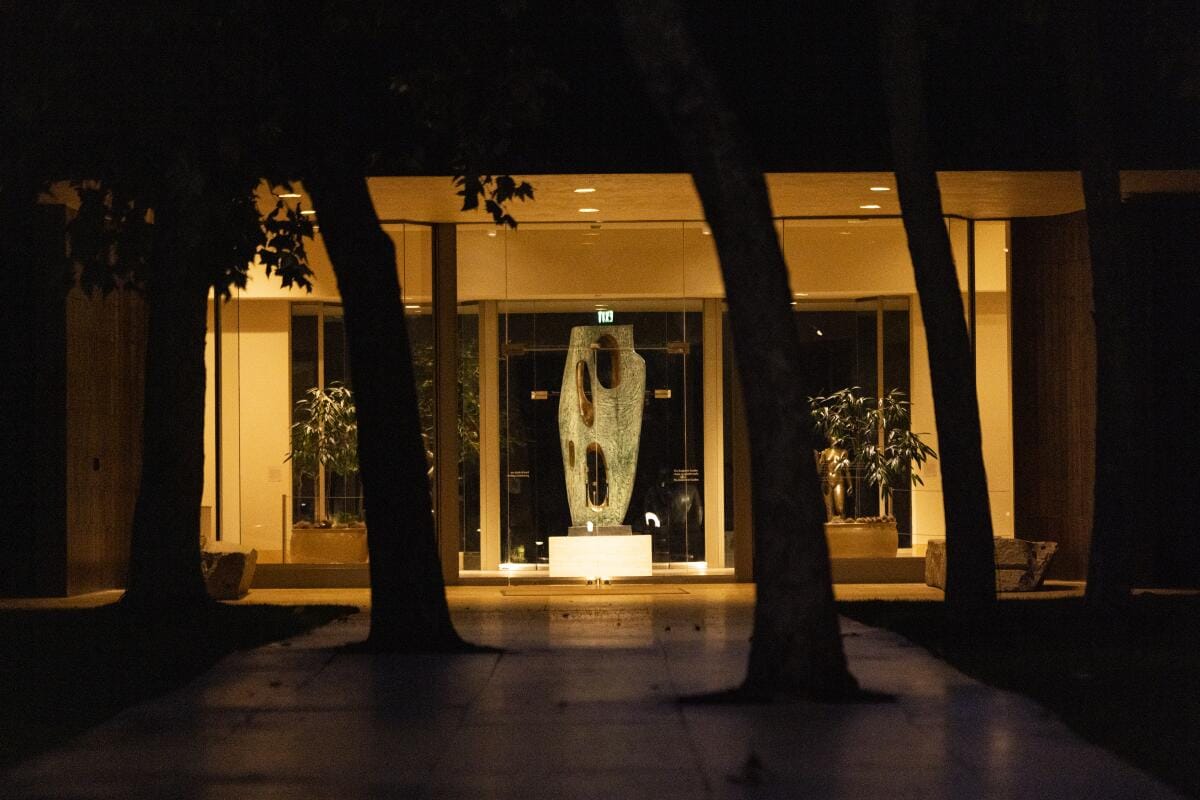
The entrance and lobby of the Norton Simon Museum. “Our collection is at the heart of everything we do,” said chief curator Emily Talbot.
(Etienne Laurent / For The Times)
“It’s interesting, because a lot of times building elements are seen as owned by the architect,” said MacLean of the Heath tiles. “And this is a finish done by someone outside of the architecture firm and architecture world, which is really exciting.”
Thanks to her work on the Norton Simon, Heath became in 1971 the first non-architect to win the Industrial Arts Medal from the American Institute of Architects, helping launch her career.
“It really is a work of art,” said MacLean. “It’s more than just a building.”
It’s also what’s inside that building, said Talbot, which is coming into focus with the 50th anniversary celebrations.
“Our collection is at the heart of everything that we do,” she said.
Fittingly, “The Thinker” has been moved to a prominent spot by the new pedestrian entrance, where everyone can see it — and take an obligatory selfie — on their way to the front doors.
